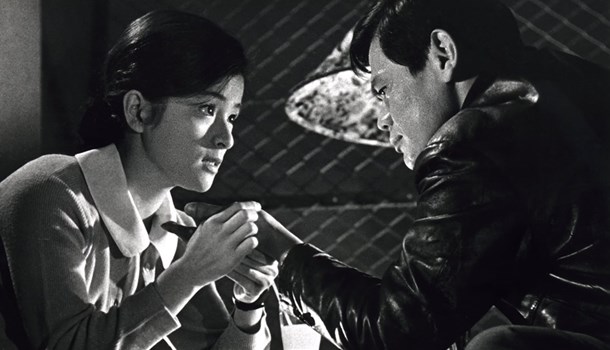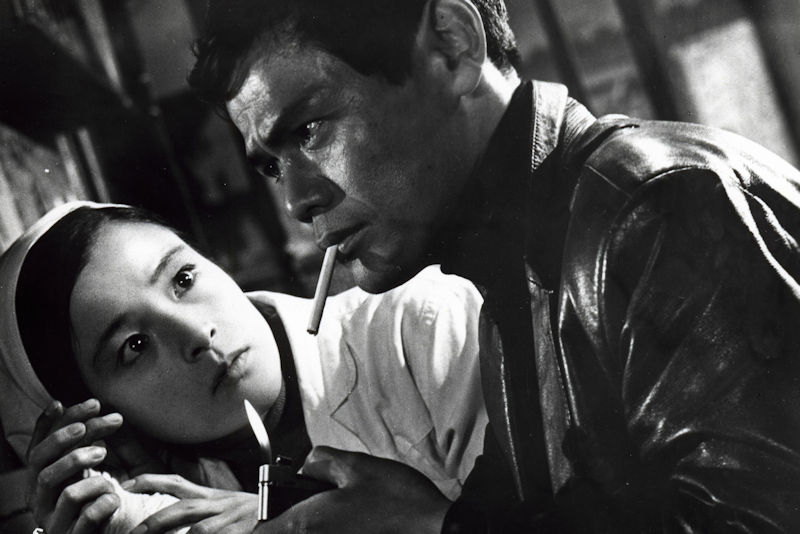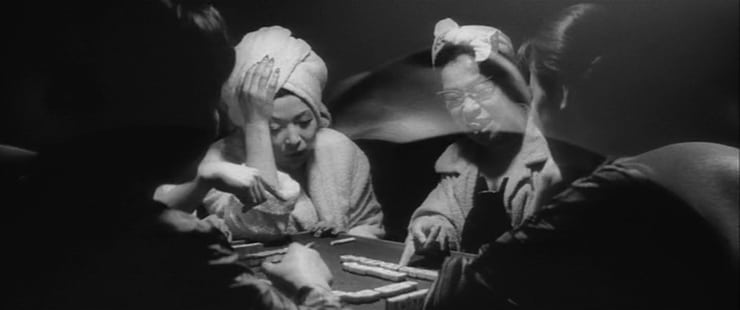
Written by Richard Durrance on 07 Feb 2024
Distributor Radiance • Certificate 18 • Price £17.99
I, the Executioner (1968) is, unless I blinked and missed it, the first film I’ve seen by Tai Kato. It’s fair to say I know nothing about him as a director and yet from the first moments of I, the Executioner I knew this was right. Just right. It was so in my arc but I was struggling to know why, yet I felt it in that visceral way you rarely ever do, but when it hits... Oh do you feel it.
If I had to try and pin anything down perhaps those first few frames of film, the tone, the images, the content and how it was handled. Oh yes, that intangible something that the best films have was there in abundance, even if I could not say where I’d felt the same tone before. Yes, I thought of Suzuki’s Branded to Kill, but that was the black and white widescreen surely... There are hints of that film but perhaps more in the sense of iconoclasm -suggestions of Imamura in tone, too, maybe?
I am sure at this point you will have realised I was feeling excited and it’s honestly a rare thing. I recently watched one of the supposedly great coming of age films: Truffaut's The 400 Blows for the first time and it was fine, well made, performances were very good, but I felt no particular spark (unlike coincidentally Radiance’s release of Truffaut's slightly later The Bride Wore Black). I could understand why people liked the film but there was no hair-on-the-back-of-the-neck-standing-up moment, whereas here there was a great feeling that here was a film I wanted to immediately know better and a director I felt I wanted to know more about, to see more films by, and I was barely five minutes in.
I appreciate how we feel about art is often a mixture of time and place: how we feel at a point in time matters enormously just as what we relate to most effectively emphasises that – and art can give us energy or sap us. Here the situation was normal, and the effect was instantaneous.
A man, Kawashima (Makoto Sato), rapes and murders a woman, but before she dies, he makes her write down a list of names. All women. What revenge is he is planning and why?
Most important of all here is tone and that is what I instantly picked up on. Where the first images of the film, the opening scene, could have been distasteful considering what it portrays, though it has a brutal directness it is not titillation, there is no sense of the film trying to glorify what it is showing: as I watched it I conjured the words: brutally discreet directness. The scene is not meant to be pleasant, but it is not filmed in an unpleasant way. Moments of sexual assault are not sexualised, not lingered upon but more to the point I could recognise without understanding where the story was going that what I was seeing was integral to the narrative. This was not merely playing to an audience but like all great storytelling, the narrative is already set and what we are being shown fits into the overarching story, even if we are in the dark. It may seem a simple statement but it’s key because throughout the film as I would discover there is a great feeling of narrative and character unity. When we learn the ultimate truth what is clear is how the narrative could fall apart but instead it is consistent and effective.
It’s worth stopping to focus on characters because they are so integral: the five women in peril are distinct, though some are only seen briefly. Part of the brilliance of the film is how we learn so much in such a short amount of time, how their relationship is so distinctly brought into focus, so at times how they seem to feel about each seems quite paper thin... or is it? Characterisation we may take at face value suddenly comes into even sharper focus as the film develops. Equally how Kawashima is viewed could be simple and he never is, just as the woman he falls for, Haru, who could be just some nice girl, is so much deeper than she ever needs to be, and her resonance narratively, as well as in relation to Kawashima, shows us just how richly the film develops character. This depth of characterisation, consistently applied throughout, is done with remarkable subtlety.

And this doesn’t even begin to talk to many of the visual aspects of the film, which are the equal of the storytelling and the characterisation. In part it is very recognisable mid-to-late-60s and yet of a kind, the kind that is trying to visually discombobulate and in doing so reflect the story. Kato uses a fascinating mix of long shots and close-ups, often shot at disturbing angles and unusually framed. Throughout he uses techniques with similar effectiveness, such as high contrast lighting in the flashbacks (similar to Suzuki’s contemporaneous Fighting Elegy, though contextually different), which has the effect of being visually engaging while also allowing a certain obfuscation that works for the film. It leaves you subtly on edge, throws you off kilter and correctly so, the film is mystery of sorts, a thriller of a kind, and noirish in tone with its moral ambiguity.
There’s gallows humour too, to leaven what are the darker aspects of the film, but much of it is not where it could be: like the detective who has piles, which could be made fun of, but the film treats the detective who has piles as a part of his life. Nothing to laugh at, or joke about. It speaks to how all the characters are people, fleshed out and realised even if shown in passing. There is a grounded sense of life, of realness, even if what we see on screen is nothing hopefully any of us will have to see and witness.
The women and the reality of their crime once we learn it, like the detective with piles, could almost be a joke, treated pruriently whereas how Kato allows the surprising denouement to unfold is treated thoughtfully and in many ways the revelation is not so important. Because it’s the journey of our characters to the end, it's the surprising bonds that we learn about and the layers that are shed as we discover the startling and brilliant cinematic world of Tai Kato. It's rare to be as engrossed by a film, and to come across one with no obvious flaws, or even, at want of sounding unintentionally negative one that isn’t obviously brilliant because of single thing. Rather than the film being brought together by one great performance, here there is a troop of actors who all inhabit their parts, who appear to live in the diegetic world and their connections and history they wear as lightly as their clothes. The mastery of tone and visual impact added to that depth of characterisation and narrative nihilism wrap up what on the surface may seem to be a serial killer film, but seeks to explore - if not give - answers, similar to Imamura’s Vengeance is Mine; or within a different genre but one that also explores violence and sexual violence, Masumura’s Red Angel. It is true that the punishment that Kawashima metes out to the women is not merited but the film also posits almost in passing that the women’s crime is not something that society is capable of taking with any seriousness, despite the terrible consequences of it.
I’m not sure that I, the Executioner has a moral to its story, and it doesn’t need one, it is better for not having one as it is a film where moral complexities relating to hero and villain are so mixed that neither role really exist, and we come to realise one of the great tragedies of the film is that often redemption is just a moment away but the potential for it can also come a moment too late. The die has already been cast.
Arguably I, the Executioner is the best film I've seen in some time and illustrates the continued importance and need to support the release of physical media. Radiance have released an unjustly neglected film by Tai Kato, a protege of Akira Kurosawa, and one that stands up against the best of its era or any era, and which can be proud of its sophistication of character, cinematic tone and visual impact, and most of all is utterly disturbingly compelling.
This makes me very excited for Radiance’s next Kato release: By A Man's Face Shall You Know Him.


Long-time anime dilettante and general lover of cinema. Obsessive re-watcher of 'stuff'. Has issues with dubs. Will go off on tangents about other things that no one else cares about but is sadly passionate about. (Also, parentheses come as standard.) Looks curiously like Jo Shishido, hamster cheeks and all.
posted by Richard Durrance on 17 Dec 2025
posted by Richard Durrance on 12 Dec 2025
posted by Ross Locksley on 09 Dec 2025
posted by Richard Durrance on 28 Nov 2025
posted by Richard Durrance on 25 Nov 2025
posted by Richard Durrance on 18 Nov 2025
posted by Richard Durrance on 14 Nov 2025
posted by Richard Durrance on 11 Nov 2025